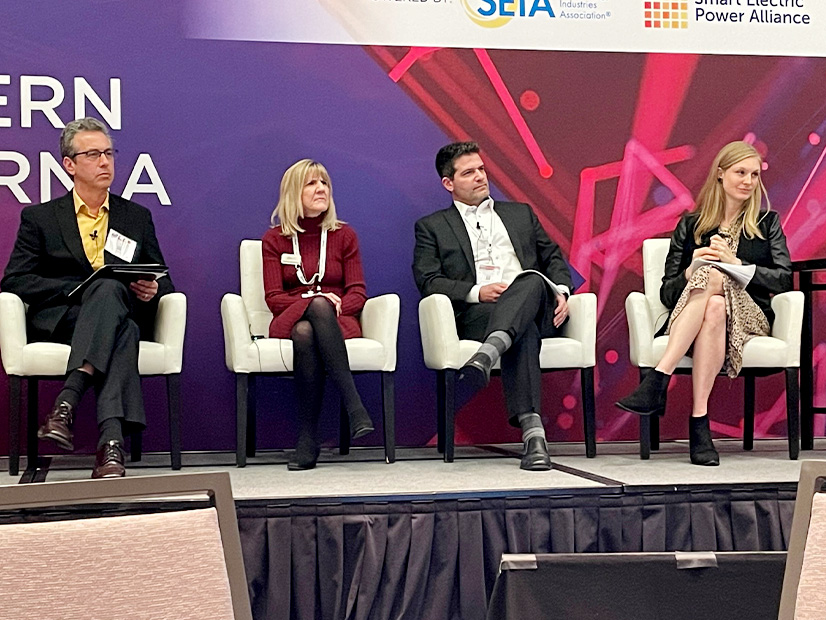
SACRAMENTO, Calif. — Careful utility rate design could lessen the impact on ratepayers of California’s expensive efforts to reach 100% clean energy and harden the grid against wildfires, panelists said at last week’s RE+ Northern California conference, sponsored by the Solar Energy Industries Association (SEIA) and Smart Electric Power Alliance (SEPA).
The panel addressed the state’s steeply increasing utility bills, which are projected to keep rising in coming years. Much of the increases are to pay for the costs of new generation and distribution and transmission system upgrades, the California Public Utilities Commission said in its 2022 annual report to the governor and legislature on actions to limit rate increases.
“Increasingly, there’s a big chunk of the utility bill that involves costs that are unaffected by usage, unaffected by customer demand,” said Matthew Freedman, staff attorney at ratepayer watchdog The Utility Reform Network (TURN). “When utilities spend a lot of money on wildfire mitigation, whether you reduce your usage or increase your usage in a given area has no effect on the wildfire mitigation costs, on the wildfire liability insurance costs, on a lot of the grid hardening that’s being done — and of course [on] a lot of the public purpose programs and other policy initiatives where costs are included in rates.”
TURN backed last year’s Assembly Bill 205, which included a requirement that the CPUC establish income-graduated fixed charges “so that a low-income ratepayer … would realize a lower average monthly bill without making any changes in usage.” The CPUC has asked parties to file opening testimony in its proceedings to implement the measure by March 7.
“We think it makes sense to do a fixed charge as long as you can differentiate it [by income], and to think about how that fits with other rate design strategies that will allow us to promote electrification in a rational manner,” Freedman said.
Julia Pyper, vice president of public affairs for GoodLeap, a financing company for rooftop solar and other green home improvements, said her firm also supported AB 205’s income-tiered fixed charges but has concerns about how the CPUC will implement them. Lowering electric bills for some customers could dissuade them from investing in energy upgrades, she said.
“Are we talking about 80 bucks a month? Are we talking $10 a month?” Pyper asked. “We’re all kind of in agreement that this was a good direction to go in, but so much will come down … to where that charge lands. Because if you take away all incentives for the customer to take action, then we can’t engage them in decarbonization efforts.”
‘Critical Enabler’
Jeanne Armstrong, senior regulatory counsel with SEIA, said income-tiered fixed charges “could ease the pressure on low-income customers in the short term” but finding ways to reduce utility costs remains vital.
“In the long term, if you don’t actually bring down the costs, you’re going to reach a crisis point again,” Armstrong said.
“I’m going to give an example,” she said. “Back in the early 2000s, when California had an energy crisis and … electricity bills [went] through the roof,” the legislature passed emergency legislation that directed the CPUC to “not raise rates in the first two tiers of what then was a five-tier utility rate structure. So, all the revenue increases went into tiers three through five, and lo and behold, those skyrocketed.”
The CPUC and legislature eventually revamped the rate structure.
“They brought five tiers down to two … and things were good again for a while, and we went on our merry way,” she said. But “because costs weren’t reined in, we’re once again having an affordability crisis. So, I think in the short term, this income-tiered fixed charge can help, but if we don’t do something on the cost in the long term, it won’t.”
Michael Backstrom, vice president of regulatory affairs for Southern California Edison, responded, “I’ll respectfully disagree.”
“I think that it is both a short-term and a long-term benefit to have a fixed-charge structure in electricity bills because of where we want to go from a decarbonization standpoint,” Backstrom said. “Perpetuating the system we have today, where all costs just get loaded into a per-kilowatt-hour charge, does not reflect the idea that in the long run, to achieve our decarbonization goals, we are going to want the customer to be more interested,” in investing in transportation and building decarbonization. “So having a sustainable rate structure [that includes] a fixed charge is going to be a pretty critical enabler.”
Reducing bills by 10 to 20% for low-income customers will “give those same customers the opportunity to adopt electrification technologies that are going to be very helpful to them, and that are better for the local region and reducing air pollution,” he said. “Does it solve the affordability issue? No. But it will be a big, big, big benefit in getting us into the right area.”
